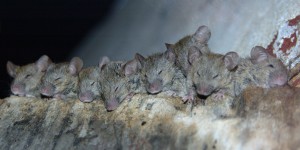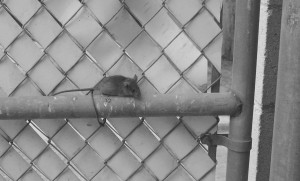Among one of the most prevalent pests, house mice rank as one of the most costliest rodents in North America.1 Because of their small size, house mice gain entry into buildings much easier than other small animals. Resilient and resourceful, mice thrive under a variety of conditions. Consuming food meant for humans, pets, livestock, and other animals, mice can be found in a multitude of types of residential buildings and commercial enterprises.
Not only can they cause damage to structures and property, mice also can transmit pathogens harmful to humans and animals. One example is salmonellosis, a type of food poisoning.
Most Common Type of Rodent in Buildings
 Mouse infestations have been estimated to be about 10-20 times more common than rat infestations.2 This likely has to do with their ease of entry into buildings. They also are able to thrive in very different types of conditions. Needing limited amounts of food and shelter, house mice can survive with limited resources. As long as their basic needs are met, house mice can continue to multiply.
Mouse infestations have been estimated to be about 10-20 times more common than rat infestations.2 This likely has to do with their ease of entry into buildings. They also are able to thrive in very different types of conditions. Needing limited amounts of food and shelter, house mice can survive with limited resources. As long as their basic needs are met, house mice can continue to multiply.
How to Control House Mice
Effective pest control means three things:
1. Population Reduction
In an infestation, reduction of the mouse population is the first step. This can be achieved through trapping and/or baiting with the use of an attractant and appropriate rodenticide.
2. Sanitation
Anywhere food is present, mice can survive despite the level of sanitation. Good sanitation cannot control mice once they have gained entry. However, poor sanitary conditions will attract mice if they are not already present. Secondly, poor sanitation will also permit mice to thrive and reproduce in greater numbers than areas with better sanitation.
Areas where food is stored or handled, mice will utilize. These areas must be paid attention to. Access to food is what allows the mice to survive. In addition, areas where mice find shelter need to be attended to. Mice need places to build nests, hide, and keep their young.
Good sanitation forms a good preventative measure against mice. Although sanitation measures can’t eliminate a rodent problem that is already underway, good sanitation can prevent mice from entering a building once the existing mice have been exterminated.
3. Exclusion
Exclusion is the best way to ensure permanent elimination of house mice. It means to make sure that your building is fortressed against mice gaining entry. Eliminating gaps and openings, sealing cracks and plugging holes with suitable material are ways to keep mice out of a building for good.
Once an initial mouse infestation has been controlled, proper handling of the building with regard to rodent exclusion procedure needs to be carried out. An inspection for gaps, opening and cracks with the proper sealing of these areas, as well as for doors and windows is a must. With regard to proper sealing, gnawable materials such as rubber, vinyl, foam, wood and other materials are not suitable to keep out mice.
When You Call the Professionals
 Pest control services know how to reduce the mouse population in your house, the best sanitary practices and common pitfalls, as well as how to best exclude mouse from re-entering the property.
Pest control services know how to reduce the mouse population in your house, the best sanitary practices and common pitfalls, as well as how to best exclude mouse from re-entering the property.
Pest control technicians have experience and expertise in knowing the common behaviour of mice, common hiding/breeding grounds, as well as typical access points to food. They have the most up-to-date knowledge about rodenticide, the dangers of it and the best way to apply it.
Mice can quickly become an insidious problem if you don’t take immediate action.
References
1. UC ANR Publication 7483, R. M. Timm, UC Research and Extension Center, Hopland, UC Statewide Integrated Pest Management Program University of California, Davis, CA 95616, October 2011
2. Supra, UC ANR Publication 7483